Drawings of Cartoon Forty Niners
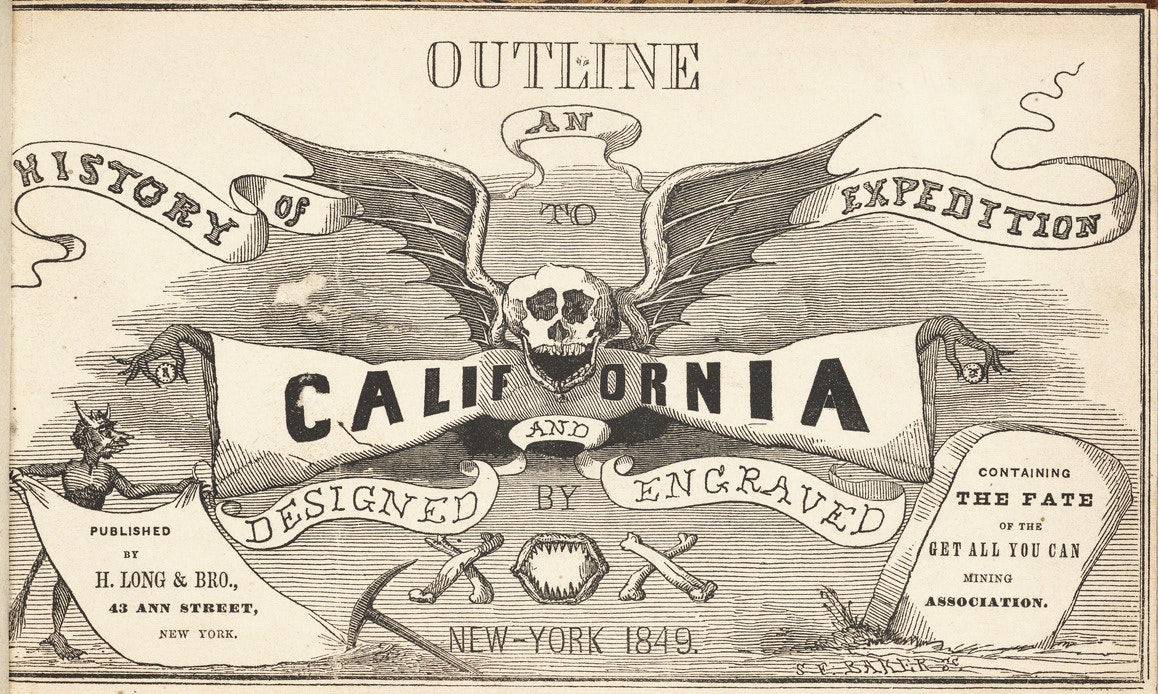 Scroll through the whole page to download all images before printing.
Scroll through the whole page to download all images before printing.
Title page to Outline History of an Expedition to California (1849), one of the early American comics about the Californian Gold Rush — Source.
There is something funny about the California Gold Rush. The sequence of events, real though they are, have all the makings of a tall tale — or a grim joke.
On January 24, 1848, James Marshall, who was overseeing the construction of a sawmill on the American River in Coloma, California, accidentally discovered gold. News spread fast. By the end of 1849, an estimated 80,000 people — predominantly men, about half of whom hailed from the urbanized northeastern United States1 — had traveled to the West Coast in one of three ways: overland, through Indian Territory; by ship, sailing around Cape Horn; or by steamer to Panama, where they crossed the Isthmus and caught a second steamer to San Francisco.
According to the tall-tale version of events, the forty-niners arrived and, as long as they worked hard, endured the wilderness, and survived the rough-and-tumble culture of New California, they were in a pretty good position to strike it rich. According to the grim-joke angle, these same forty-niners arrived with dreams of "picking up gold by the bushel"2 only to find that mining work was arduous, Californian inflation outrageous, and the likelihood of making money almost nil.3
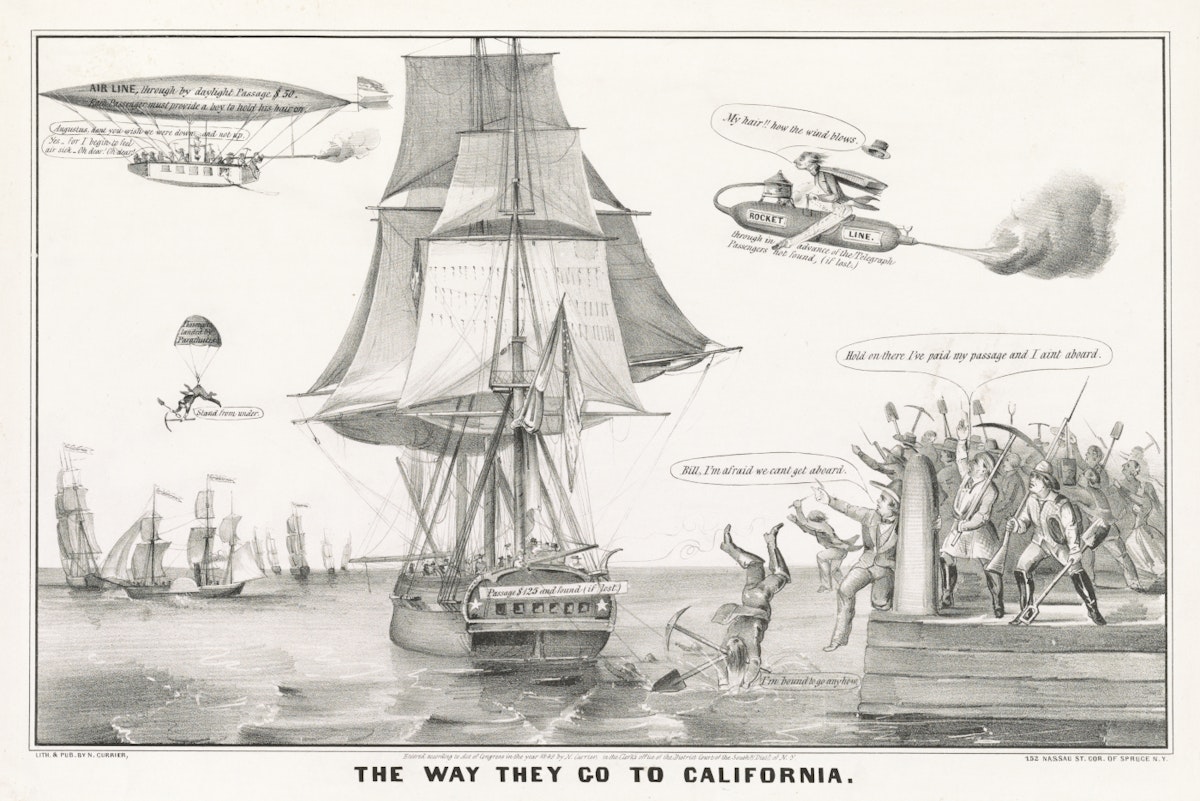 Scroll through the whole page to download all images before printing.
Scroll through the whole page to download all images before printing.
The Way They Go to California (1849), published by N. Currier — Source.
The truth seems to be somewhere in between these two extremes. Approximately half of the forty-niners turned a profit either as miners or merchants — although these profits seldom approached the life-changing jackpots they'd imagined back home. For every Levi Strauss (whose denim empire was founded in San Francisco in 1853), there were countless others whose fortunes remained unaltered or who were ruined by the costly voyage and the frequently bloodthirsty hunt for gold. This is not even to mention the damage done to African American, Chinese, and Mexican forty-niners by the violent racism rampant among disappointed whites. "Any mysterious outrage was attributed to 'Mexicans'", Josiah Royce wrote in his 1886 history of California; "any American wretch who chanced to find it useful could in moments of excitement divert suspicion from himself, by mentioning the Mexicans in general, or any particular Mexicans, as the authors of his crimes."4
This is only one of many aspects of the Gold Rush that continue to cast a shadow on American culture. Whatever the consequences for individual forty-niners — one in twelve of whom were killed by disease, accident, or human violence — the discovery of gold in Coloma produced tremendous changes in the nation.5 It relocated hundreds of thousands of settlers, transformed the village of Yerba Buena into the city of San Francisco, polluted western waters, destroyed the soil, and led to the dispossession and genocide of more than ten thousand Native Californians.
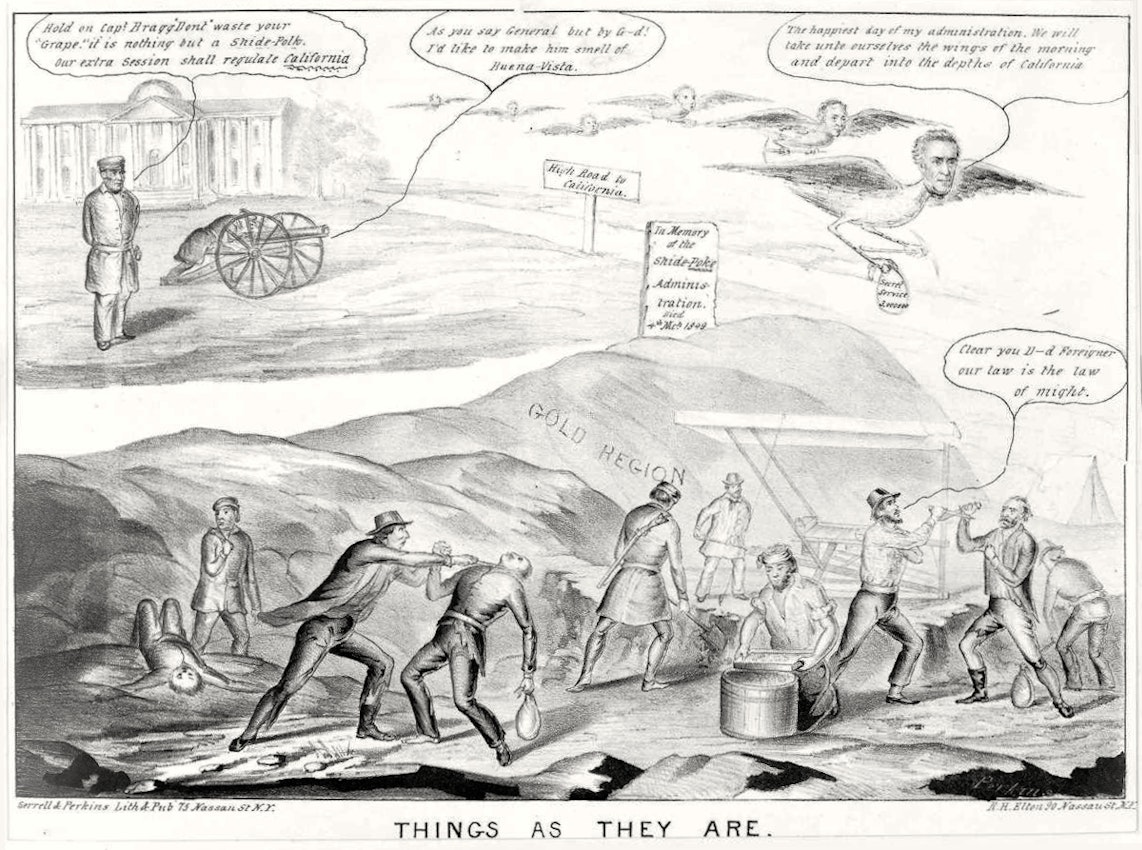 Scroll through the whole page to download all images before printing.
Scroll through the whole page to download all images before printing.
Things as They Are (1849), by Henry Serrell & S. Lee Perkins. Note the caption in the bottom right-hand corner: "Clear you D[amne]d Foreigner our law is the law of might." — Source.
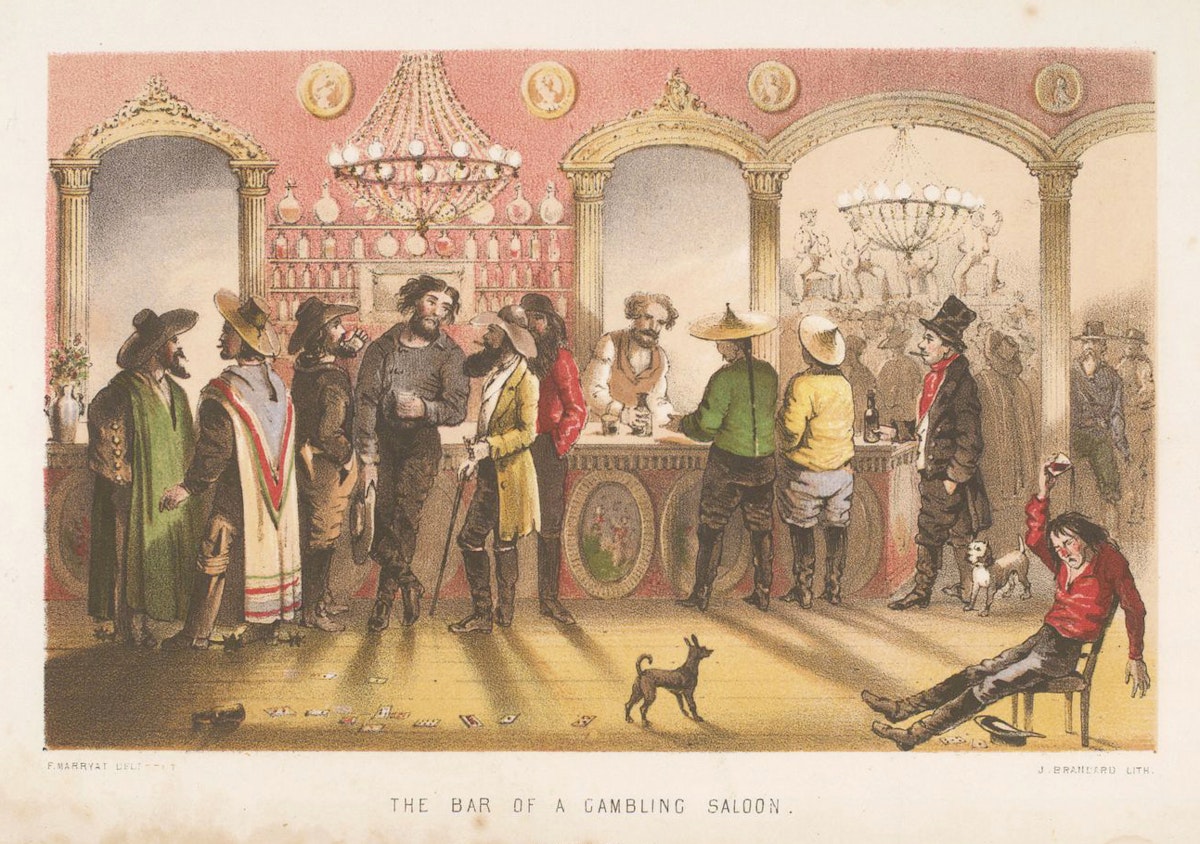 Scroll through the whole page to download all images before printing.
Scroll through the whole page to download all images before printing.
J. Brandard, The Bar of a Gambling Saloon, lithograph from Frank Marryat's Mountains and Molehills, or Recollections of a Burnt Journal, 1855 — Source.
The Gold Rush also introduced new figures into the American imagination. The Chinese worker with his wide palm-fiber field hat, the frontiersman with his sugar loaf or panama, the Mexican with his sombrero, and (most out of place of all) the effete urban Easterner struck with gold fever who's gone west on a wing and a prayer. This Easterner was not solely a figure of the imagination, either. While no small number of forty-niners were desperate or destitute, many others were thoroughly middle-class city-dwellers who, as Brian Roberts writes, "joined the rush for a variety of reasons: for gold, to be sure, but also to escape… the stultifying walls of moral codes and lawyers' offices".6 These men did not conform to their contemporaries' idea of who belonged in California any better than they conform to the popular image of the Wild West today. The Independent Gold Hunter on His Way to California, printed by Currier & Ives, is emblematic of the satirical view many Easterners took of their "Argonaut" brethren. Laden with pots and pans, a string of sausages and a shovel, the would-be prospector is shown in his town clothes, striding along, still 1700 miles from his destination — the very picture of foolhardiness.
 Scroll through the whole page to download all images before printing.
Scroll through the whole page to download all images before printing.
The Independent Gold Hunter on His Way to California: I neither Borrow nor Lend (ca. 1849), published by N. Currier — Source.
Narratives quickly attached themselves to this laughable figure, emphasizing both the real and the imagined dangers that could be encountered on a journey to the West. For those going overland, these included immense unmapped distances, hostile Native Americans (whose territory was being violated), starvation, dehydration, and disease. For those going by way of Panama, there were the added possibilities of being shipwrecked, eaten by an alligator, or stranded in a foreign land. For those going around Cape Horn, there were all the usual perils of a long ocean journey conducted entirely by wind and sail. Over all these narratives hung the question why? Why leave home and hearth? Why forsake civilization? Why risk life and limb for an improbable promise of wealth?
Questions like these were implicit not only in the lithographs and cartoons of these years, but also in a form recently introduced to North America: the comic book.7 In The Adventures of Mr. Tom Plump (ca. 1850), Journey to the Gold Diggins (1849), and Outline History of an Expedition to California (1849), the figure of the Eastern Argonaut was set into motion and put to the test.
The Adventures of Mr. Tom Plump, a children's book, is by far the least sophisticated of the bunch. Its drawings are stiff, its captions brief, and its story is demented. An unlikely-looking schoolboy called Mr. Tom Plump, who is — you guessed it — plump, runs away from his Eastern home and sets sail for California. Once there, Mr. Plump "gets poor" (meaning he loses weight) and finds some gold, which disappears when his mule is frightened by a bear. On arriving back home, he in turn frightens his parents, who don't recognize him now that he's thin. Soon enough, however, "good living makes him fat again" and, having married a woman who can dance the polka, Mr. Tom Plump drowns in a river after falling through a bridge. This is a shaggy dog story if ever there was one. Besides getting seasick and losing his gold, Mr. Tom Plump's adventures don't have much to do with the adventures experienced by actual forty-niners.
Browse through The Adventures of Mr. Tom Plump (ca. 1850), published by Philip J. Cozans, using the book reader above — Source.
Journey to the Gold Diggins, illustrated and probably written by J. A. and D. F. Read, is a masterpiece by comparison. Its seascapes and grotesque human figures look forward to the elaborate comics art of Tony Millionaire, and its story — about a skeletal "urban dandy" called Jeremiah Saddlebags — has a dreamlike coherence.
Saddlebags, learning that his aunt has died and left him five hundred dollars, decides to invest the money in a trip to California. The prospect of prospecting excites him. In fact, it excites him so much he does a jig, alarming the neighbors, who've never known him to be so noisy before. Mortified at being caught while jigging, Saddlebags "considers he has made a fool of himself" (a sign of self-conscious "Eastern" oversensitivity that, we are supposed to understand, doesn't bode well for his chances in the insensitive, hyper-masculine West).
The subsequent action of Journey to the Gold Diggins is so relentless, it really demands to be recounted in a single breath. So, here goes: Saying goodbye to his fiancée, Saddlebags boards a ship to Panama, confronts an alligator, avoids being scalped (thanks to a well-placed wig), is captured by pirates, made to join their number, is captured by the military, saved from being hanged by an old friend, travels to "the diggins", squabbles with fellow miners, finds a huge lump of gold, is divested of it, gambles for a smaller lump, sets off overland back east, eats bones with bears, is captured by Native Americans, made to join their number, escapes, returns to his hometown, is pursued by a racist mob who mistake him for a Native American, learns his gold is worthless, and entertains his fiancée by "recounting his adventures".
 Scroll through the whole page to download all images before printing.
Scroll through the whole page to download all images before printing.
Page from Journey to the Gold Diggins (1849) by J. A. and D. F. Read — Source.
Browse through J. A. and D. F. Read's Journey to the Gold Diggins (1849) by using the book reader above — Source.
Like The Adventures of Mr. Tom Plump, Journey to the Gold Diggins is about a man who has no business going west and, economically speaking, gains nothing by doing so. Yet Saddlebags at least comes out of it with a tale to tell — a tale that perhaps makes him more satisfied with his settled life back East. By extension, Journey to the Gold Diggins seems designed to regale its Eastern readers with a sensational story that reassures them about their decision to stay home, looking down their noses at dupes like Saddlebags who squander their lives in a greedy search for gold.
Greed is explicitly the theme of Outline History of an Expedition to California (1849), which is less focused on a single character than either Journey to the Gold Diggins or Mr. Tom Plump. Instead, it offers a sort of panoramic view of the Gold Rush, following parties bound for California by all three major routes. At the center of this narrative swirl is, naturally, an Easterner, Jonathan Swapwell of Swapville (a not-so-subtle indication he is a New England merchant), who travels from his hometown to New York City and from New York City to California, going by all three routes at once! This mind-bending approach allows the author (the decidedly anonymous XOX) to depict multiple perilous journeys simultaneously. While the overland party trudges across the muddy Great Plains, the "Cape Horners" are shipwrecked and the "Panamains" wait perpetually for the San Francisco steamer to come.
Somehow, one of the Jonathan Swapwells arrives at the California mines, where he and his partner, Pat, become successful merchants, swapping and dealing with the miners. As it turns out, they will be the only two figures in the book who escape the place unscathed. Jonathan, overhearing some miners planning to rob him, decamps at night with just enough gold to make a decent life for himself back in Swapville. (Pat, suffering the fate of minor characters since time immemorial, travels with him as far as the ship before vanishing.) But what might be merely dreary middle-class moralism is livened up by a frame story involving Death and the Devil, who start off this History by lacing a hole in California with golden "bait" and end it by filling up the "cavity made by the extraction of gold, with the bones of those who perished in its pursuit".
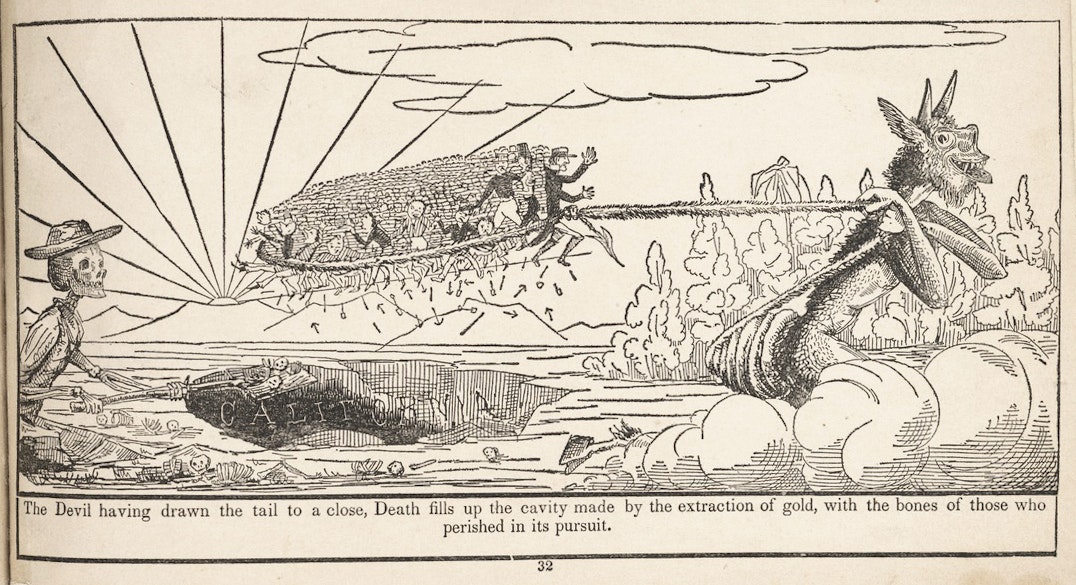 Scroll through the whole page to download all images before printing.
Scroll through the whole page to download all images before printing.
Last panel from Outline History of an Expedition to California (1849) — Source.
Browse through Outline History of an Expedition to California (1849) by using the book reader above — Source.
None of these early comics would have existed had the Gold Rush not occurred, but they were not, of course, pure products of events. Their creators were inspired by newspaper stories, lithographs, and word-of-mouth legends — as well as by the world's first comic strip, Rodolphe Töpffer's Histoire de M. Vieux Bois (Geneva, 1837), translated into English as The Adventures of Mr. Obadiah Oldbuck and illegally published in America as early as 1842. This Swiss volume follows the melancholy yet feverish exertions of its title character in pursuit of his "lady love", including several suicide attempts, a couple of prison breaks, and one escape from premature burial.
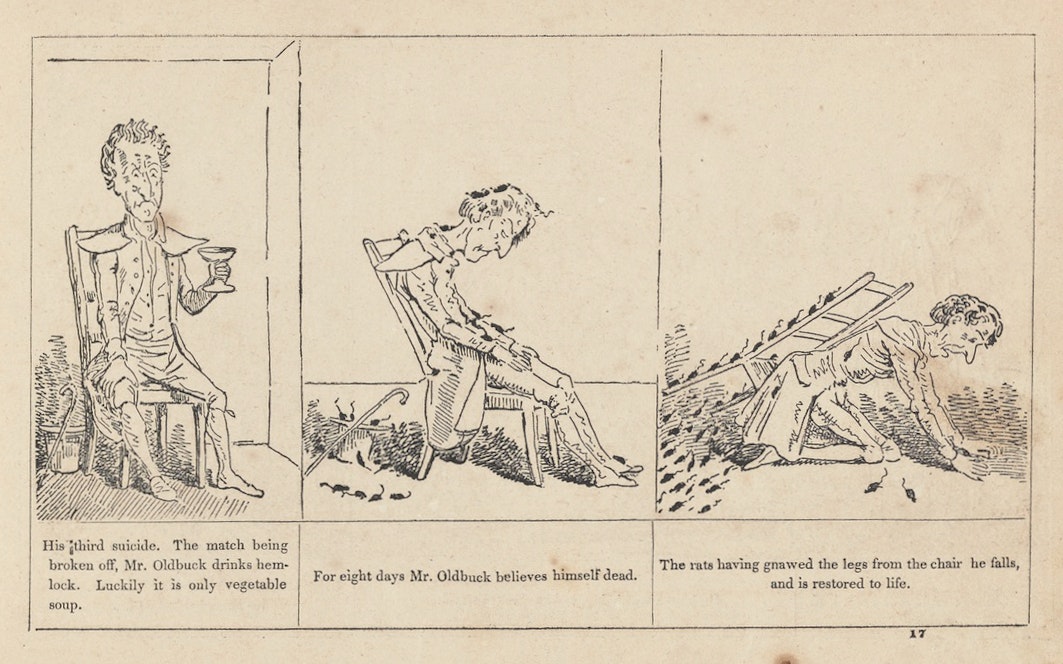 Scroll through the whole page to download all images before printing.
Scroll through the whole page to download all images before printing.
Page from the ca. 1844 English edition of Rodolphe Töpffer's The Adventures of Mr. Obadiah Oldbuck — Source.
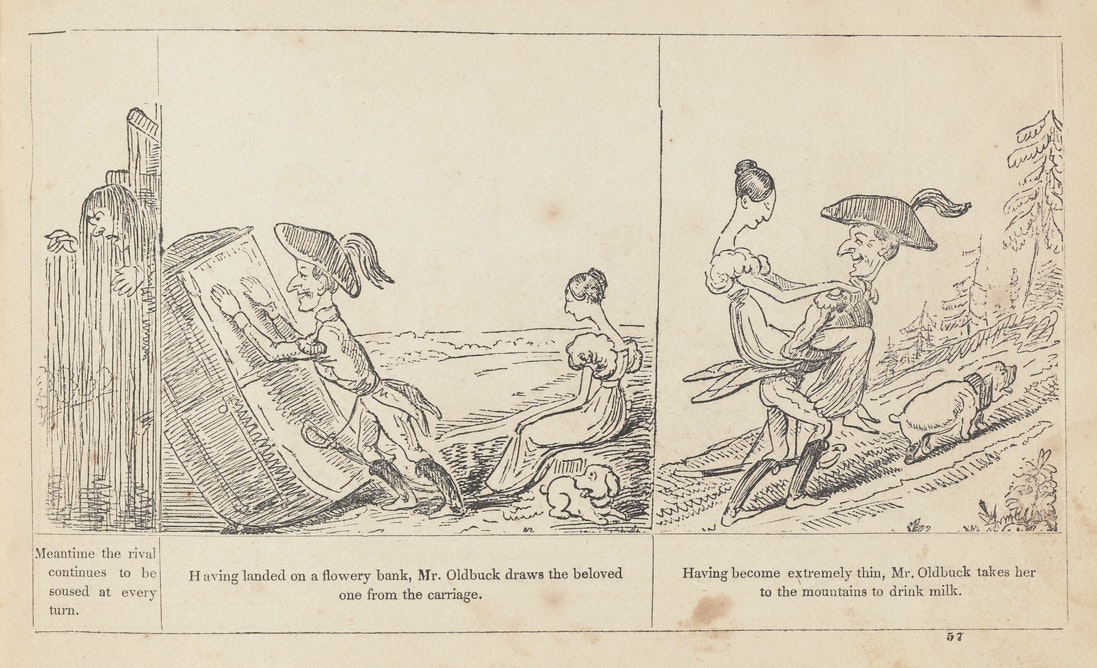 Scroll through the whole page to download all images before printing.
Scroll through the whole page to download all images before printing.
Page from the ca. 1844 English edition of Rodolphe Töpffer's The Adventures of Mr. Obadiah Oldbuck — Source.
Töpffer's ridiculous lovesick European served as a model for American artists depicting ridiculous gold-sick Easterners. The author of The Adventures of Mr. Tom Plump, for example, took something from Töpffer's obsession with human forms that alternate between fat and thin, while the authors of Journey to the Gold Diggins imitated not only Oldbuck's oblong format but also specific postures and scenes.
 Scroll through the whole page to download all images before printing.
Scroll through the whole page to download all images before printing.
Comparison showing similar scenes: the first and third images from The Adventures of Mr. Obadiah Oldbuck (1844 English edition), and the second and fourth from Journey to the Gold Diggins (1849).
The urban Easterner out of his element in the West proved to be an abiding figure in the American imagination.8 Even after the Gold Rush, the young man who decides to light out for the territories would appear time and again. In John Williams' novel Butcher's Crossing (1960), he is Will Andrews, a preacher's son from Boston who wants to commune with the natural world but, going on a buffalo hunt in 1870s Colorado, finds himself merely participating in mindless slaughter. In Jim Jarmusch's movie Dead Man (1995), he is William Blake, an accountant from Cleveland who intends to take a job at the metal works in the Western town of Machine but ends up wounded and wanted, transformed into an outlaw in the wilderness.
Such characters personify, just as surely as Jeremiah Saddlebags, the anxieties that surrounded the voluntary mass migration to the West. The upheaval that followed the discovery of gold in California in 1848 made clear how willing even "civilized" Easterners were to leave their homes at the drop of a hat. The greedy, the desperate, the aimless, the ambitious, the curious, the romantic — all found reasons to go. Civilization, with its wage work and promise of relative security, was no match for their dreams of a better, freer life out in the great unknown. This part of the Gold Rush story, at least, still holds us in its sway.
Alex Andriesse received his doctorate in English literature from Boston College in 2013. His writing has appeared or is forthcoming in Granta, 3:AM Magazine, and The Millions. His translation of Chateaubriand's Memoirs from Beyond the Grave, 1768–1800 is published by NYRB Classics, and another translation, of Roberto Bazlen's Notes Without a Text, is forthcoming from Dalkey Archive Press in 2019. In addition to editing the Review of Contemporary Fiction, he has also edited two volumes of the anthology Best European Fiction. He lives in the Netherlands. Find him on Twitter here
Drawings of Cartoon Forty Niners
Source: https://publicdomainreview.org/essay/comic-gold-the-easterner-goes-west-in-three-early-american-comics/
0 Response to "Drawings of Cartoon Forty Niners"
Post a Comment